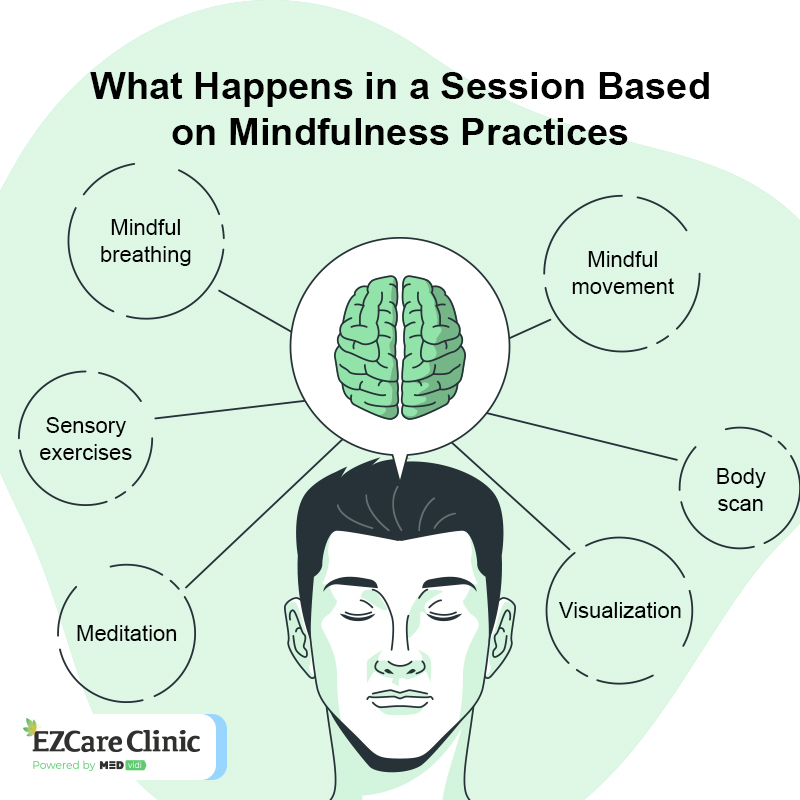From a secular, therapeutic perspective, mindfulness means an individual’s conscious self-awareness at the moment.
As a therapy, mindfulness treats many mental conditions, including anxiety.
Mindfulness is used alongside other therapeutic interventions, including:
- Acceptance and Commitment Therapy (ACT)
- Dialectical Behavior Therapy (DBT)
- Cognitive-Based Therapy (CBT)
Though some of its practices may lead to relaxation, mindfulness group therapy has nothing to do with relaxation.
Instead, mindfulness focuses on increasing individuals’ awareness of their thoughts, actions, and feelings that hinder their progress.
Mindfulness therapy focuses on being aware of your emotions, thoughts, and surroundings- Click below to schedule your appointment.
How Do You Teach Mindfulness in Group Therapy?
Mindfulness as group therapy is a training process that you can use to equip participants with skills to improve their lifestyles. Mindfulness develops with time, and it requires the participants to be willing and humble.
As you start teaching mindfulness to participants, you must emphasize its positive aspects and encourage best practices.
If anything, it’s easier to teach something only after the participants appreciate its importance in their lives.
To effectively teach mindfulness, observe the following:
-
Demonstrate What You Teach
It’s not enough to tell people what they should do. They will understand it better when you show them how to do it and then guide them to do it by themselves.

Activities in a Session-Based on Mindfulness Practices
-
Be Honest
It’s best to explain to the participants how effective mindfulness is by acknowledging what you’ve personally experienced.
-
Mindfulness Is Practical
Of course, your audience will start practicing mindfulness the moment you start the training. Mindfulness training can only succeed when the participants participate in its practical aspects.
What Are the Four Mindfulness Group Therapy Techniques?
The four mindfulness techniques include:
1. RAIN
RAIN is an acronym for recognize, allow (acknowledge), investigate, and non-identify.
RAIN is about recognizing when an individual has strong emotions and acknowledging the presence of the emotions. It is also about investigating and inquiring about the individual’s mind, feelings, and body reactions.
Finally, it’s about non-identification, which helps understand that intense emotion is a passing state of mind and not a definition of who the individual is.
Get professional help managing your emotions-Click below to schedule your appointment with a mental health professional.
2. STOP
STOP is an acronym for “Stop, Take a breath, Observe, and Proceed.” When practicing mindfulness, you have to stop everything you do to concentrate. Next, take a deep breath, then observe your emotions, feelings, and thoughts.
Lastly, proceed with an activity that supports your emotions, like talking to someone.
3. Walk
Walking is a mindfulness activity that’s easy to incorporate into your daily routines. Walking will help you focus on your legs, feet, and toes. It also allows you to feel, smell, and taste what’s around you. It’s among the easiest mindfulness group activities.
4. Shower
Often, when in the shower, you only focus on bathing and getting out.
However, you should know that the shower provides an excellent opportunity to practice mindfulness.
You can take time to smell the soap, feel the sensation of water on your skin, and do anything that helps you concentrate on your sensations.
How Do You Create a Mindfulness Group?
A mindfulness group is formed by people willing to perform all the suggested exercises or activities and attend all mindful meetings.
To form a mindfulness group, you must decide who will be in the group and where you will conduct its activities. You can start with a group of trusted friends and decide where to meet.
The next step is to choose mindfulness group therapy activities. You may choose simple activities like sitting meditations, 5 minute guided meditation, reading, or talking. Working together helps the participants to share their questions, difficulties, and joys.
Another thing to think about is facilitation. Mindfulness group therapy exercises and activities need a facilitator.
Identify some members of the group who are knowledgeable about mindfulness and assign them the days to facilitate.
If no one can facilitate it, you can hire an expert for this job. A good facilitator can promote a stable and safe environment for group members to mediate and effectively engage with each other.

Mindfulness Group Therapy Helps With These Conditions
What Are The Limitations Of Mindfulness-Based Group Therapy?
Though mindfulness has many advantages, this therapy has some limitations, including:
-
Less Creativity
Though mindfulness helps in dealing with problems that require analytical thinking, it has been found not to enhance creativity, meaning it can’t help with problems that require insight.
-
Narcissism
Narcissism is a side effect of mindfulness. When you practice mindfulness, it will enhance your self-esteem, making you excessively aggressive towards other people. This will make you feel as if you are superior to others.
-
Psychosis, Mania, and Dissociation
Mindfulness may lead to a feeling of dissociation. It can sometimes make you feel disconnected from your body and dissociated from people. In extreme cases, you can become manic, anxious, and psychotic.
In mindfulness group therapy, mindfulness practices are often used in combination with other mental health treatments– Click below to schedule your appointment with a licensed professional.
Conclusion
Mindfulness is an effective therapy, but it requires commitment. Despite the above limitations, it remains an effective therapy for dealing with lack of focus, stress, and depression.
If you feel disconnected, manic, or dissociated, or if a friend has told you that you are becoming overconfident, you must practice mindfulness in moderation.
Many scientific studies back the benefits of mindfulness group therapy.
Click the banner below to schedule your appointment.

